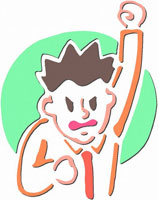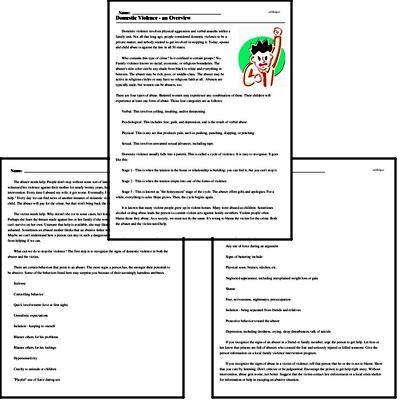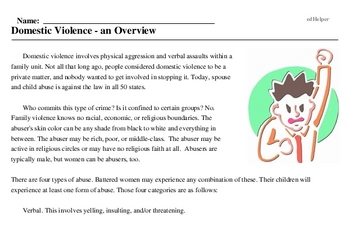Domestic Violence - an Overview
Domestic Violence Month
Reading Comprehension for October 13
Domestic violence involves physical aggression and verbal assaults within a family unit. Not all that long ago, people considered domestic violence to be a private matter, and nobody wanted to get involved in stopping it. Today, spouse and child abuse is against the law in all 50 states.
Who commits this type of crime? Is it confined to certain groups? No. Family violence knows no racial, economic, or religious boundaries. The abuser's skin color can be any shade from black to white and everything in between. The abuser may be rich, poor, or middle-class. The abuser may be active in religious circles or may have no religious faith at all. Abusers are typically male, but women can be abusers, too.
There are four types of abuse. Battered women may experience any combination of these. Their children will experience at least one form of abuse. Those four categories are as follows:
Verbal. This involves yelling, insulting, and/or threatening.
Psychological. This includes fear, guilt, and depression, and is the result of verbal abuse.
Physical. This is any act that produces pain, such as pushing, punching, slapping, or pinching.
Sexual. This involves unwanted sexual advances, including rape.
Domestic violence usually falls into a pattern. This is called a cycle of violence. It is easy to recognize. It goes like this:
Stage 1 - This is when the tension in the home or relationship is building; you can feel it, but you can't stop it.
Stage 2 - This is when the tension erupts into one of the forms of violence.
Stage 3 - This is known as "the honeymoon" stage of the cycle. The abuser offers gifts and apologies. For a while, everything is calm. Hope grows. Then, the cycle begins again.
It is known that many violent people grew up in violent homes. Many were abused as children. Sometimes alcohol or drug abuse leads the person to commit violent acts against family members. Violent people often blame those they abuse. As a society, we must not do the same. It's wrong to blame the victim for the crime. Both the abuser and the victim need help.
The abuser needs help. People don't stop without some sort of intervention. One man, whose daughters witnessed his violence against their mother for nearly twenty years, had this to say. "It never gets better without intervention. Every time I abused my wife, it got worse. Eventually, I would have killed her if I hadn't gotten help." Every day we can find news of another instance of domestic violence that led to the death of an adult or child. The abuser will pay for the crime, but that won't bring back the victim.




